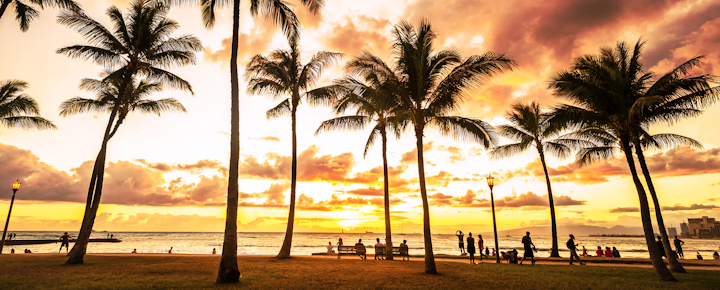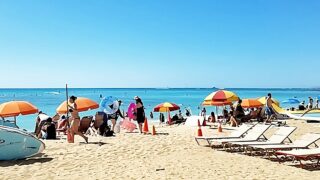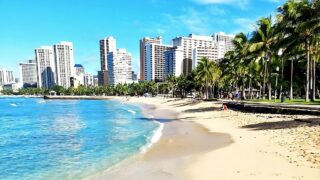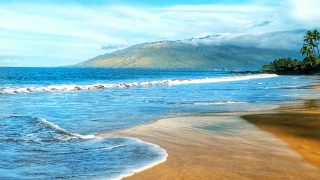The Hawaii Tourism Authority (HTA) just announced a major partnership with Japan’s three largest tour operators, HIS, JALPAK, and JTB Hawaiʻi, and awarded them their new and “prestigious” Qurator certification.
However, what’s noticeably absent from this list of Qurator certified companies are any similar U.S. based travel tour operators.
The lack of inclusion of major U.S. travel agencies like Pleasant Holidays, Delta Vacations, and Apple Vacations appears striking.
The Qurator program, launched by the HTA in 2024, is designed to certify businesses that meet rigorous standards of responsible tourism across six categories: environment, cultural support, equity, safety, community, and guest experience.
The missing U.S. operators, among others, have long played critical roles in bringing mainland travelers to Hawaii, yet appear absent from Qurator’s recognition. Why hasn’t HTA engaged with or delivered these domestic operators in the same way as their Japanese counterparts?
With Hawaii Governor Josh Green having made multiple trips to Japan to promote tourism, there often seems to be a recurring pattern of prioritizing international tourism over domestic ones.
Meanwhile the number of Japanese visitors to Hawaii remains at a fraction of the pre-pandemic level, when 1.5 million Japanese tourists visited annually. In August, for example, Hawaii saw 64k visitors from Japan, while more than 600k came from the U.S. mainland, emphasizing the critical role domestic tourism plays in sustaining Hawaii’s economy.
This raises a question for many U.S. visitors: Is Hawaiiʻi placing a greater emphasis on Japanese visitors at the expense of domestic travelers? And is that appropriate now or ever?
Governor Green’s focus on Japan over domestic travelers.
The governor has made several recent high-profile trips to Japan to promote tourism, which has long been an important market for Hawaii. In contrast, however, there has been little visible effort by the Governor to encourage domestic tourism, even though U.S. travelers from the mainland—especially the West Coast—by far make up the bulk of visitors to Hawaii.
In Hawaiʻi Tourism Authority Now Says U.S. Mainland Visitors Desperately Needed, we explored the importance of domestic tourists and how HTA has acknowledged their critical role. However, there seems to be no comparable governor-led initiative aimed at attracting U.S. visitors. As a result, some may feel that domestic tourists are taken for granted while international relationships, particularly with Japan, are prioritized.
This focus on Japan is significant, particularly since U.S. visitors have sustained Hawaii’s tourism industry during tough times, like the COVID-19 pandemic, when international travel was heavily restricted.
A tilt toward Japanese visitors: What does it mean for U.S. tourists?
Hawaii’s emphasis on Japanese visitors, especially through initiatives like the Qurator program, at least thus far, could send the message that international travelers are more valued than their domestic counterparts. It’s worth noting that visitors from Japan have historically spent more per day and stayed longer in the islands, which might be factors in this apparent tilt.
However, U.S. tourists have consistently been the backbone of Hawaii’s tourism economy, especially when global circumstances such as today’s limit international arrivals. The absence of major U.S. tour operators from the Qurator program may inadvertently alienate some loyal domestic travelers.
Could this perceived preference for international visitors, particularly from Japan, lead to a decline in U.S. visitor loyalty? Or will domestic travelers continue to visit without regard to the state’s focus elsewhere?
Major U.S. tour operators left out of Qurator?
The omission of major U.S.-based travel agencies from HTA’s Qurator program remains a mystery. Companies like Pleasant Holidays, YMT Vacations, and Delta Vacations have been integral in supporting Hawaii’s tourism industry.
Pleasant Holidays, for example, has been a significant player in Hawaii travel offerings for sixty-five years! These companies offer comprehensive vacation packages or components that connect mainland visitors to the islands.
By allowing these companies to remain outside of the program that promotes responsible and sustainable tourism, HTA risks overlooking an opportunity to engage these U.S. operators in the broader conversation about sustainable tourism in Hawaii.
Is this exclusion deliberate, an oversight, an afterthought, or a lack of effort to engage them?
On the other hand, domestic operators may be less aligned with HTA’s vision for the future of Hawaii tourism. This could be a situation where they choose not to participate in Qurator.
That brings up the larger discussion of which businesses are part of Qurator. Hilton Hawaiian Village, Hawaii’s largest hotel, is apparently also not participating, while the more “boutique-style” Equus Hotel has chosen to take part.
Challenges for Japanese visitors to Hawaii.
While Hawaii remains a top dream destination for many Japanese travelers, the current economic situation, including the depreciating value of the yen and rising costs in Hawaii, are making it harder for most Japanese to visit.
There’s a growing sentiment that Hawaii has become a destination for wealthier travelers, which may drive younger or middle-income tourists to opt for more affordable alternatives, including Southeast Asia and Europe.
Beat of Hawaii editors noted the strength of rebounding Japanese tourism in Europe this past summer. In response, All Nippon Airways (ANA), for example, is expanding its European network, adding more routes and increasing its passenger lift.
Perception of Hawaii’s costs.
Media reports in Japan regularly highlight how expensive Hawaii has become, emphasizing the soaring costs of accommodations, dining, and activities, particularly in popular areas like Waikiki. This has created a sense that Hawaii is increasingly unaffordable for the average Japanese traveler, contributing to the belief that Hawaii is now a luxury-only destination, out of reach for many, especially younger and middle-income travelers.
Hawaii tourism: A call for balance and inclusivity.
As Hawaii’s tourism industry continues to recover and reshape itself in the new world of travel, the state must adopt a more balanced approach. While the Japanese market is undoubtedly valuable, domestic travelers have proven to be the sole reliable and consistent source of most Hawaii tourism revenue.
To ensure that Hawaii doesn’t alienate a critical portion of its visitor base, state leadership needs to engage U.S. travel operators. U.S. companies should be included in certifications like Qurator, promoting sustainability and responsible tourism practices domestically.
Additionally, the state, including the HTA and the governor, should promote domestic tourism. Just as Japan is being prioritized, parallel efforts should be made to encourage and retain U.S. tourists, whose visits have supported Hawaii through good times and bad.
If Hawaii hopes to continue thriving as a top destination for international and domestic travelers, a unified strategy is needed, wherein Hawaii’s tourism appropriately balances the interests of both international and domestic markets to ensure long-term success. That will help ensure that all visitors feel valued as participants in our islands’ future.
Please share your thoughts.
Get Breaking Hawaii Travel News







It must be in what they spend but also what they expect to tip. Japanese expect like 30% tip or they are insulted so maybe more Japanese tourists will leave bigger tips. Hard to believe when the yen is 6 cents to the dollar. Japanese seldom complain and most of the time price don’t matter because they brag about how much things cost in self pride. Good luck with souvenier’s because nothing is made in Hawaii. Most items I saw were made in Malaysia, Taiwan, Phillippines, or Republic of China. IMO this topic is one way for the mainland tourist to be told they are not welcome.
One word for the HTA: “Delusional”…
Best Regards
“Why hasn’t HTA engaged with or delivered these domestic operators”? Maybe because domestic tourism has been dominating the total visitor count in recent years without any help, while the share of Japanese tourism has declined? And because foreign visitors spend more per person than domestic visitors, resulting in less overcrowding per dollar of revenue brought in?
Wasting our tax $$$ for tourist that can’t afford Hawaii…..
My husband and I visited Maui every year since 1988 and last year was the last. Every Canadian flight leaving and arriving home in Vancouver B.C. was always full – you are forgetting the Canadians who love Maui and are always going to turn up in the Canadian winter months.
I think it is as simple as the Governor and Mayor’s wanted to see Japan and be treated with all Japan has to offer.
Possibility they wanted to get away from all of the Controversy that they caused, leave everything behind with the hope that it will calm down before they get back. The Official Hawaiian Government Plan, light the fire 🔥 and fan the flames 🔥 then scurry away!
A couple of thoughts. The comment, “hoping to get electricity from a rope” is the best I’ve seen here in a long time. As for tourists, I couldn’t care less who visits Hawaii. I come and enjoy friends and golfing. We eat out every day, trying to support the locals. The way I see it, government is to blame for all the poor decisions being thrown out there. More so, the uninformed voters who keep electing incompetent candidates. Inform the voters and you will fix most of your problems.
Very sad! HTA is doubling down on what they said in 2021/2022. Then HTA said that they’d prefer to have Japan, or European, visitors than they would visitors from the U.S., because although they visited often they spent less. Then early 2024 HTA said they did welcome U.S. visitors, but this latest development appears to show they don’t want mainland visitors at all. I have a visit coming up soon and I guess I’ll learn if islander attitudes actually reflect HTA’s attitude. Aloha!
We’re visiting West Maui now and the Governor and mayor have done a great job convincing people to not come to West Maui, the place we’re staying is 3/4’s empty and you can just walk in to all the popular restaurants/
This is spot on. Tourism numbers are way down, restaurants half empty but it’s not shocking given the antics of Green, Blissen and Lahaina Strong to discourage tourism. I talked to two long time Maui enthusiasts today in Wailea. People who have come for long stays for 26 and 40 years. The excessive taxation and disrespect are real sore spots. Meanwhile, Maui welcomes the $4 Billion that the US mainland is committing to rebuild Lahaina.
Jus come to Kauai… The best Island….
Hmmmm, does HTA not like/welcome Mainland tourists??? I think perhaps that HTA (an organization that is a waste of millions of State dollars that could be better used to help out the displaced persons on Maui) believes that Mainland tourism doesn’t need the focus, and that it will take care of itself and always be there. Where as Japan tourism needs to be reenergized and more heavily promoted. There is a strong presence in HI of persons of Japanese ancestry, so there is that link and another reason for persons from Nippon to come and visit, outside the lovely weather.
HTA and the Governor probably believe that US tour operators and their clientele wouldn’t be as likely to responsible guests in Hawaii and should therefore be discouraged from coming. Conversely, Japanese and European tourists are perceived as being more culturally sensitive.
Could it also be that Japanese tourist are more courteous, respectful and polite. Having directly seen tourism over the past 14yrs, domestic tourist have a much different behavior. Plus, domestic tourist will come regardless.
My one experience with a Japanese tourist left me with a negative feeling towards them (tourists, not the people as a whole). The first time we came to Hawaii (years ago, we’ve been to the islands 30 times now) we went to Pearl Harbor. I darned near got shoved out of the way by a Japanese tourist trying to line up a picture. He darned near wound up in the water. It was his countrymen who were why Pearl Harbor is so important to Americans.
So much for Japanese tourists being respectful.
The HTA has been a running joke for a long time. Since the inclusion of certain members, what an additional joke and unwavering disaster, that add fuel to the existing fires 🔥 😳 Of course they want to preclude as many average people from the mainland as possible, they are outcasts! The Wealthy, Rich, and Powerful are the only target demographic that HTA is interested in. Greed is, as always, showing its face across all of Hawaii, the HTA is leading the charge. Disbanding the HTA would be Best for Hawaii, no more funding for advertising Hawaii Vacations. BTW, who hasn’t heard of Hawaii? Maybe it’s time!
“Equity”? So we know where Green stands! Gotta wonder if Green has proposed subsidizing the Japanese Tourism, with the $/Yen disparity, and hiding in Fares that include Air and Hotel in Yen, with Japanese Airlines and Japanese owned Hotels, as are the Hyatt, Halekalani, Kahala, Kaimana as well as Moana, Royal Hawaiian, Sheraton Waikiki, and Princess Kaiulani all with Japan ownership! If they think Japan tourism is done since Covid, look to the pre-millennia for real numbers! Call me cynical.
With Green, anything is more than likely. His Bosses want Rooms Filled, Timeshares Sold, Resorts Bustling with Activities, Boutique Shops and Restaurants filled! That doesn’t happen when the Japanese sit out for 2 entire years. Green and the Mayors are there to Stimulate, and be Stimulated!
Given the economics, also noted in the article, looking to Japan to sustain Hawaii tourism is like hoping to get electricity from a rope. I have never seen occupancy levels this low, even during the pandemic, in West Maui.
If Lahaina expects to rebuild, it will take tourist dollars, and lots of them, to provide funding and vibrant businesses to relocate there. The logic of focusing on Japan utterly escapes me from every aspect. It’s cheaper and easier to get to Hawaii from the West Coast, Americans tip better and spend more on average, and aren’t dealing with currency issues.
The misguided direction from this governor is breathtaking.
And that’s if there is nothing nefarious going on, as to re-development. From Lahaina Harbor to the Safeway, is about the same as from the Hyatt to Sheraton in Kaanapali, with people like Black Rock, Disney, who’s to say Lahaina isn’t recreated in some huge area like Ko Olina, Kaanapali, Wailea, Poipu, nothings been done for 14 months! Again, I’ve become more cynical watching the response to what is happening to our Cities and the recent ongoing situation in N.C./Tennessee.